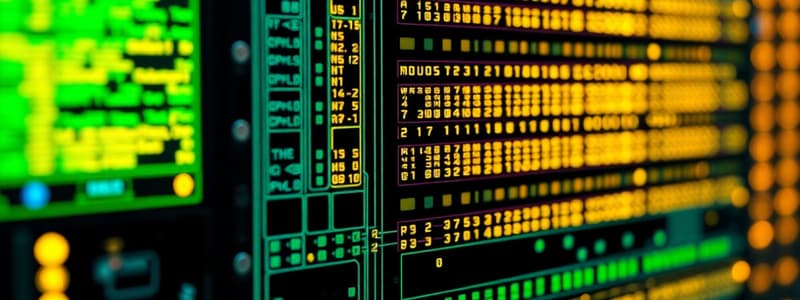Podcast
Questions and Answers
What does architecture refer to in the context of computer systems?
What does architecture refer to in the context of computer systems?
- The relation between components
- Attributes visible to the programmer (correct)
- Control signals and memory technology
- How features are implemented
What is meant by 'organization' in computer architecture?
What is meant by 'organization' in computer architecture?
- The manner in which features are implemented (correct)
- The relation between different computer families
- The instruction set and data representation
- The communication lines between components
Which of the following describes one of the primary functions of all computer systems?
Which of the following describes one of the primary functions of all computer systems?
- Control signals
- Code compatibility
- Addressing techniques
- Data processing (correct)
In terms of structure, what does the control unit do?
In terms of structure, what does the control unit do?
What does the term 'structure' refer to in computer architecture?
What does the term 'structure' refer to in computer architecture?
All Intel x86 family members share what common aspect?
All Intel x86 family members share what common aspect?
What is the primary purpose of communication lines in a computer system?
What is the primary purpose of communication lines in a computer system?
Which operation is NOT considered a fundamental function of computers?
Which operation is NOT considered a fundamental function of computers?
How do architecture and organization differ in the context of computer systems?
How do architecture and organization differ in the context of computer systems?
What is meant by code compatibility in computer architecture?
What is meant by code compatibility in computer architecture?
List the four basic functions of all computer systems.
List the four basic functions of all computer systems.
Explain the relationship between structure and function in computer systems.
Explain the relationship between structure and function in computer systems.
What roles do control signals and memory technology play in a computer system's organization?
What roles do control signals and memory technology play in a computer system's organization?
Describe the importance of the Central Processing Unit (CPU) in a computer system.
Describe the importance of the Central Processing Unit (CPU) in a computer system.
What are the differences in organization among various models within the same architecture family?
What are the differences in organization among various models within the same architecture family?
Why is the concept of 'peripherals' significant in computer structure?
Why is the concept of 'peripherals' significant in computer structure?
Study Notes
Architecture vs. Organization
- Architecture encompasses attributes visible to programmers such as instruction sets, data representation, I/O mechanisms, and addressing techniques.
- Organization refers to how features are implemented, involving control signals, interfaces, and memory technology.
Intel and IBM Architectures
- All Intel x86 family processors share the same basic architecture, enabling code compatibility, particularly backward compatibility.
- The IBM System/370 family also shares a similar architecture, with variations in organization across different versions.
Structure & Function
- Structure describes the relational arrangement of components in a computer system.
- Function refers to the operations performed by individual components within that structure.
Computer Functions
- Four primary functions of computers:
- Data processing
- Data storage
- Data movement
- Control
Top-Level Structure of a Computer
- A computer is comprised of a Central Processing Unit (CPU), Main Memory, and input/output peripherals.
- Systems interconnection connects various components through communication lines for data exchange.
Structure of the CPU
- The CPU includes an Arithmetic Logic Unit (ALU) and registers for processing data.
- The internal bus facilitates communication between different parts of the CPU and with the memory.
Structure of the Control Unit
- The Control Unit manages the sequencing of instructions and controls other units within the CPU.
- It includes registers and decoders for effective functioning, overseeing the internal bus that connects various components.
Book Outline
- The book presents a comprehensive exploration of computer architecture and organization, emphasizing structure, function, and operational components.
Architecture vs. Organization
- Architecture encompasses attributes visible to programmers such as instruction sets, data representation, I/O mechanisms, and addressing techniques.
- Organization refers to how features are implemented, involving control signals, interfaces, and memory technology.
Intel and IBM Architectures
- All Intel x86 family processors share the same basic architecture, enabling code compatibility, particularly backward compatibility.
- The IBM System/370 family also shares a similar architecture, with variations in organization across different versions.
Structure & Function
- Structure describes the relational arrangement of components in a computer system.
- Function refers to the operations performed by individual components within that structure.
Computer Functions
- Four primary functions of computers:
- Data processing
- Data storage
- Data movement
- Control
Top-Level Structure of a Computer
- A computer is comprised of a Central Processing Unit (CPU), Main Memory, and input/output peripherals.
- Systems interconnection connects various components through communication lines for data exchange.
Structure of the CPU
- The CPU includes an Arithmetic Logic Unit (ALU) and registers for processing data.
- The internal bus facilitates communication between different parts of the CPU and with the memory.
Structure of the Control Unit
- The Control Unit manages the sequencing of instructions and controls other units within the CPU.
- It includes registers and decoders for effective functioning, overseeing the internal bus that connects various components.
Book Outline
- The book presents a comprehensive exploration of computer architecture and organization, emphasizing structure, function, and operational components.
Studying That Suits You
Use AI to generate personalized quizzes and flashcards to suit your learning preferences.
Related Documents
Description
Explore the foundational concepts of computer architecture and organization in this quiz based on Chapter 1 of William Stallings' book. Understand the differences between architecture and organization, including instruction sets, data representation, and implementation techniques. Test your knowledge of key principles that form the basis of computer systems.




